WAR GRAVE
ERNEST RENE DAVIS (grave 24)
PILOT OFFICER
83 SQUADRON
ABOUT MY LIFE
Born: 21st July 1915
Died: 14th August 1941
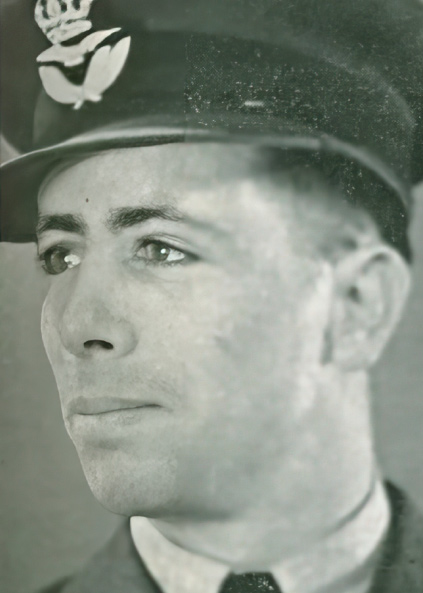
My father Christian Ernest Davis moved to Chile for work in 1913 with my mother Luz and I was born in Antofagasta on 21st July 1915. This region of Chile is known for its copper mining and a likely reason my father travelled to this area for employment.
In September 1929, I arrived in Liverpool from Coronel in Chile to continue my education. From 1929 until 1931, I attended the Brighton College in Sussex, before returning to Chile.
I married Helga Braasch in Peru in the late 1930’s. Helga had been born on 9th July 1917 in Malente-Gremsuhen, Schleswig-Holstein, Germany. Her parents had also moved to South America for work. We travelled back to England as a couple, arriving on 4th March 1940. Helga obtained employment as a nanny at Hodys Place in Wickhamford, this was to play a significant part in the accident that caused my death.
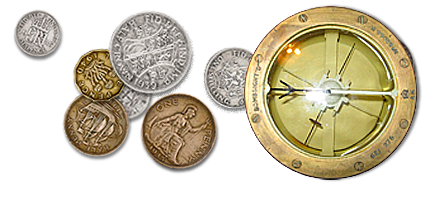
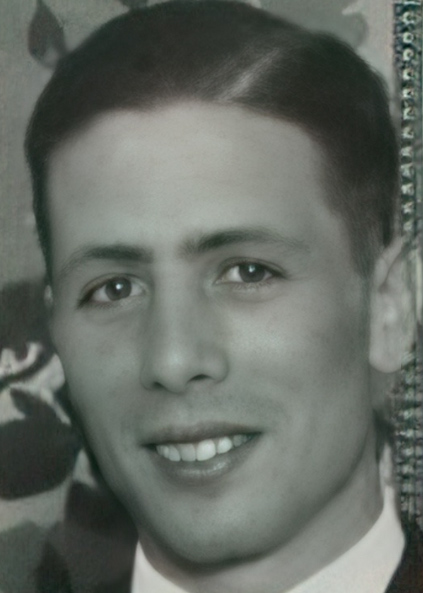
MY AIRCRAFT
The Hampden was a medium bomber with a crew of 4. Pilot, Navigator, Wireless Operator/gunner and a further gunner. Although it was a vast improvement on the biplanes 49 Squadron had been flying just before the war opened, in reality it was already obsolete. Early daylight raids had been a disaster, the bomber was too slow to evade German fighters and its guns were no match for the Germans either. The distinctive fuselage, designed to give the aircraft a sleek, aerodynamic profile, led to the Hampden earning its nickname of “The Flying suitcase”.
Crew: 4
Span: 21.09 m
Length: 16.32 m
Height: 4.37 m
Wing area: 63.90 m²
Empty weight: 5,344 kg
Loaded weight: 8,508 kg
Engine: 2 x Bristol Pegasus XVIII 9-cylinder radial engines
Engine power: 980hp each
Maximum speed: 410 km/h
Rate of climb: 5.00 m/s
Range normal: 1,095 km
4 or 6 x 7.7mm Vickers K machine guns (1 flexible, 1 nose, 1 or 2 dorsal, 1 or 2 ventral)
1,814kg of bombs/mines or 1 x 18in torpedo
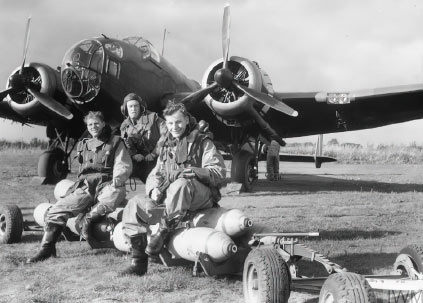
An 83 Squadron crew in front of their Hampden.
MY ROLE
I was the pilot of this aircraft.

MY SQUADRON
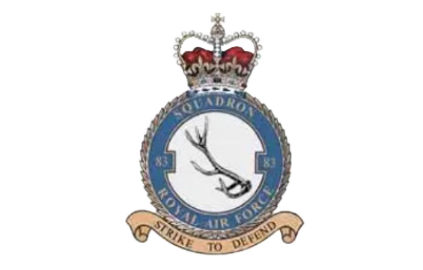
Motto: Strike to Defend
83 Squadron was formed at Montrose on 7th January 1917 as a night bomber squadron. Moving to France in March 1918, the squadron saw action on the western Front and took part in operations to counter the German’s Spring Offensive. Following the end of the war, the Squadron was disbanded on 31 December 1919.
With the threat of war once again looming over Europe, 83 squadron was reformed at RAF Turnhouse on 4th August 1936, flying the Hawker Hind biplane. In March 1938, the squadron re-equipped with Handley Page Hampdens at RAF Scampton.
In the summer of 1940, the Squadron received one of Scampton’s three Victoria Crosses due to the heroic actions of Flight Sergeant John Hannah in putting out the fire on a battle damaged Hampden.
In December 1941, the squadron re-equipped with the infamous Avro Manchester, but the poor reliability of this aircraft led to them quickly being re-equipped with the legendary Avro Lancaster, with which the squadron fought the rest of the war. In August 1942, the squadron became a pathfinder unit, leading large bomber formations to their targets and laying target indicator flares so they could be more accurately hit.
After the war, they flew Avro Lincolns and Avro Vulcans, before being disbanded in 1969.
THE ACCIDENT
I took-off from Scampton at 08:20am on what should have been a routine air-test. I was flying an 83 Squadron Hampden with the tail number AD935. At some point, I decided to visit my wife who was working as a nanny in a house called Hodys Place in Wickhamford.
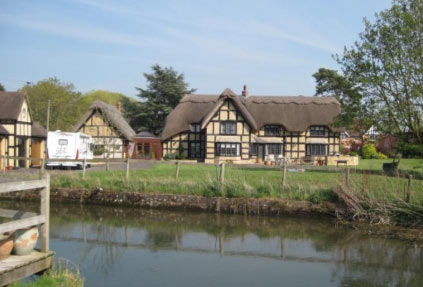
Hodys Place today.
At 12:40pm, we arrived over Wichamford and I circled over the village before performing a very low flypast over my watching wife. Almost immediately after passing the house, the aircraft clipped some trees and crashed into the next field. Also killed was Sergeant Gilbert Newbold, who is now buried in Sileby, Leicestershire. Miraculously, Sergeant W Wells survived. The written enquiry into this accident ended with the following words from the Air Officer Commanding:
“Regulations have again been brought forcibly to the notice of all crews”
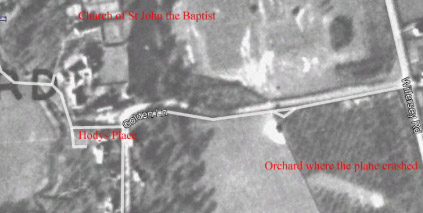
Eye-witness account from Joan Salter, then aged 13
“On Thursday August 14th 1941 there was a plane crash at 1.05. We had just finished our dinner and Dad had gone out to weigh some beans when we heard a terrible crash. We rushed outside to see thick, black smoke pouring into the sky. Dad and another man were out there watching it. Dad said he had seen the plane circling round then it hit something, turned over and crashed to the ground. Dad got out his bike and went down to help (as he was a Special Constable). A little after he had gone we heard a big explosion (a petrol tank). Mother said I could go down so I jumped on my bike and went down.
It would have landed safely only it landed in the plantation as it went along. Its wings got torn off then it burst into flames. It was a Hampden. There should have been five men in it but there were only three. The one only had his ankle twisted right round and a few cuts and bruises and the other was alive but unconscious. He was terribly knocked about and Dad thinks he would have been dead before they got him to Evesham.
As it was down, people were at their doors and children were cycling as hard as they could to the spot. It was in the middle of an apple and plum plantation. The people were out on the road close to the Lodge. When I got there it was in flames, some of them were white hot. The fire engine was there but was not putting it out. At last they fitted the pipes together and they started putting out the flames. The one part they got at but the other took longer as it was the petrol and oil cans. It kept spreading showers of white hot sparks up as the water swished down up on it. When it was out there was nothing to see except different things the constables found and were putting in a heap.
All at once the crowd pushed to the gate at the end of the field. The police were just going to lift the dead man on the lorry. It was covered up but I saw one of his hands from underneath the cover. After that I went home with Dad”.
There were some considerable acts of bravery that day, for which two local people received commendations. Researched by the Badsey Society.
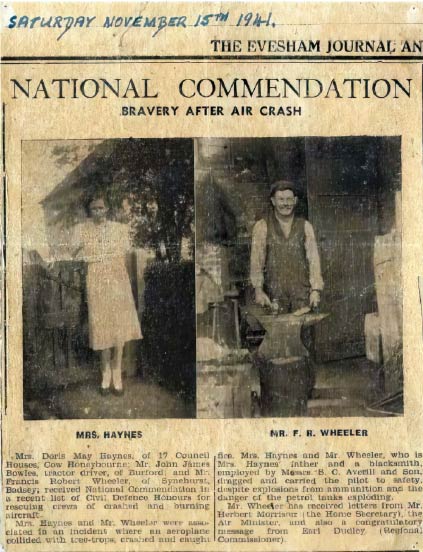
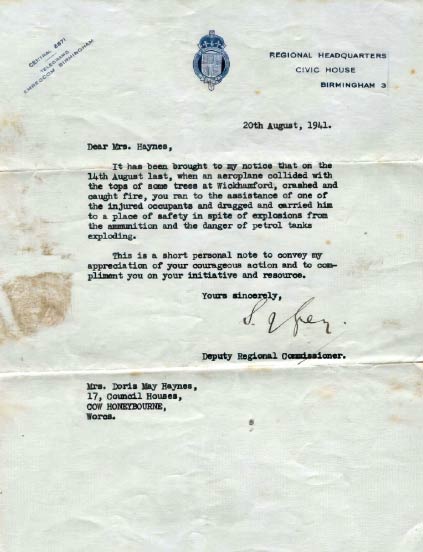
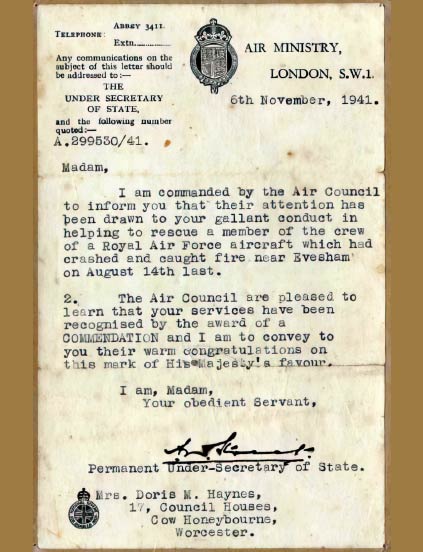
ON THIS DAY IN WORLD WAR TWO – 14TH AUGUST 1941
The German spy Josef Jakobs is executed by firing squad in the Tower of London.
Winston Churchill and President Roosevelt sign the Atlantic Charter.
Where Next
Visit Wickhamford near Evesham.
